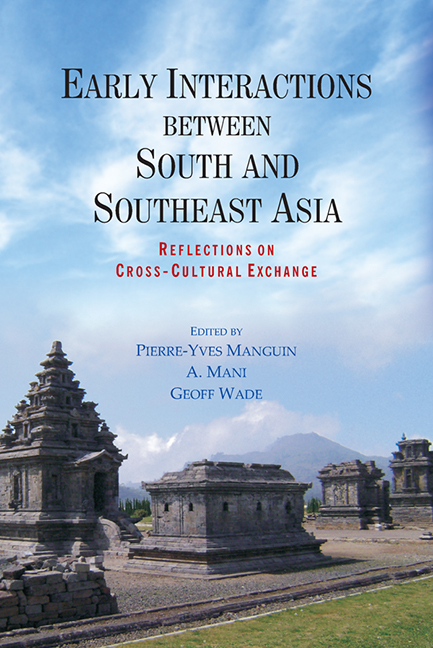Book contents
- Frontmatter
- Contents
- FOREWORD
- Preface
- Introduction
- PART I New Archaeological Evidence from South Asia and Southeast Asia
- 1 Central Vietnam during the Period from 500 BCE to CE 500
- 2 Ban Don Ta Phet and Khao Sam Kaeo: The Earliest Indian Contacts Re-assessed
- 3 Preliminary Study of Indian and Indian Style Wares from Khao Sam Kaeo (Chumphon, Peninsular Thailand), Fourth-Second Centuries BCE
- 4 Early Contacts between India and the Andaman Coast in Thailand from the Second Century BCE to Eleventh Century CE
- 5 The Batujaya Site: New Evidence of Early Indian Infl uence in West Java
- 6 Continuity and Change in South Indian Involvement in Northern Sumatra: The Inferences of Archaeological Evidence from Kota Cina and Lamreh
- 7 South Asia and the Tapanuli Area (North-West Sumatra): Ninth-Fourteenth Centuries CE
- 8 Emergence of Early Historic Trade in Peninsular India
- 9 Contacts between India and Southeast Asia in Ceramic and Boat Building Traditions
- 10 Marine Archaeological Investigations along the Tamil Nadu Coast and their Implications for Understanding Cultural Expansion to Southeast Asian Countries
- PART II Localisation in Southeast Asia
- LIST OF CONTRIBUTORS
- INDEX
8 - Emergence of Early Historic Trade in Peninsular India
from PART I - New Archaeological Evidence from South Asia and Southeast Asia
Published online by Cambridge University Press: 21 October 2015
- Frontmatter
- Contents
- FOREWORD
- Preface
- Introduction
- PART I New Archaeological Evidence from South Asia and Southeast Asia
- 1 Central Vietnam during the Period from 500 BCE to CE 500
- 2 Ban Don Ta Phet and Khao Sam Kaeo: The Earliest Indian Contacts Re-assessed
- 3 Preliminary Study of Indian and Indian Style Wares from Khao Sam Kaeo (Chumphon, Peninsular Thailand), Fourth-Second Centuries BCE
- 4 Early Contacts between India and the Andaman Coast in Thailand from the Second Century BCE to Eleventh Century CE
- 5 The Batujaya Site: New Evidence of Early Indian Infl uence in West Java
- 6 Continuity and Change in South Indian Involvement in Northern Sumatra: The Inferences of Archaeological Evidence from Kota Cina and Lamreh
- 7 South Asia and the Tapanuli Area (North-West Sumatra): Ninth-Fourteenth Centuries CE
- 8 Emergence of Early Historic Trade in Peninsular India
- 9 Contacts between India and Southeast Asia in Ceramic and Boat Building Traditions
- 10 Marine Archaeological Investigations along the Tamil Nadu Coast and their Implications for Understanding Cultural Expansion to Southeast Asian Countries
- PART II Localisation in Southeast Asia
- LIST OF CONTRIBUTORS
- INDEX
Summary
INTRODUCTION
One geographical area dealing with transoceanic trade covers the present states of Kerala and Tamil Nadu. It formed a distinctive linguistic identity and cultural homogeneity, particularly during the early historic period. The Tamil language and Tamil-Brahmi script is found engraved on memorial stones, caves, coins, seals, rings and on ceramics in the above geographical zone with great uniformity. These inscribed objects clearly suggest a common language with its own script, established as a native language well before the third century BCE, one of the prerequisites for trade. This linguistic uniformity would not have been achieved without minimum, continuous cultural interaction. The striking similarity observed in various Iron Age monuments clearly points to the emergence of cultural homogeneity. The available archaeological sites further suggest that human occupation was widespread and transcended different ecological zones (Fig. 8.1). The continuous human occupation led to resource mobilization leading in turn to resource transactions through trade. The long survival of trade centres and port towns located in an economically viable resource zone are fine indicators of its natural growth and expansion (Fig. 8.2). The exploitation of natural resources like iron ore, pearl fishery, gemstone industry, spices, forest products, etc., transformed the cultural matrix of the place through the introduction of new technology in the area of production and in transportation. The state protection and formation of trade guilds had an indirect impact on development of trade. These multiple factors played a crucial role in maintaining these commercial activities over a period. The present study attempts to focus on the trade that existed between fifth century BCE and third century CE. These dynamic trading activities have been discussed in the backdrop of recent archaeological evidence that surfaced in India, Sri Lanka, Southeast Asia and the West.
The long survival of Iron Age monuments spanning over one thousand years shows the establishment of settlements in different ecological zones. It shows no cultural break between the Iron Age and early historic phase though there is a marked difference in ways of life. The manifold activities of the Iron Age people have been observed in the late phase of Iron Age.
- Type
- Chapter
- Information
- Early Interactions between South and Southeast AsiaReflections on Cross-Cultural Exchange, pp. 177 - 196Publisher: ISEAS–Yusof Ishak InstitutePrint publication year: 2011

